从韦努蒂归化与异化法看中英文习语翻译
- 格式:doc
- 大小:44.50 KB
- 文档页数:19
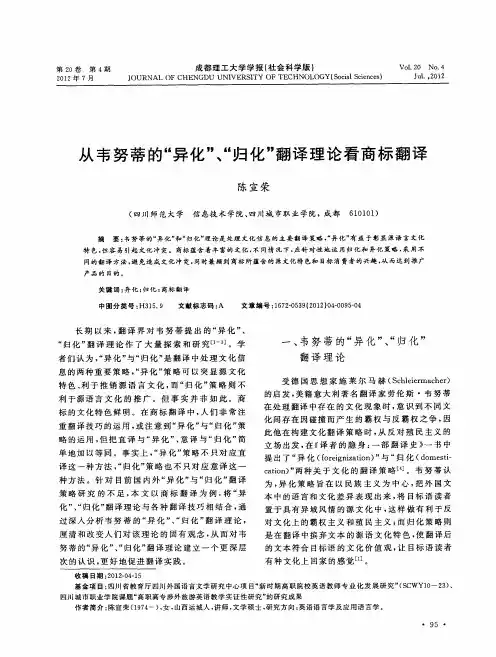
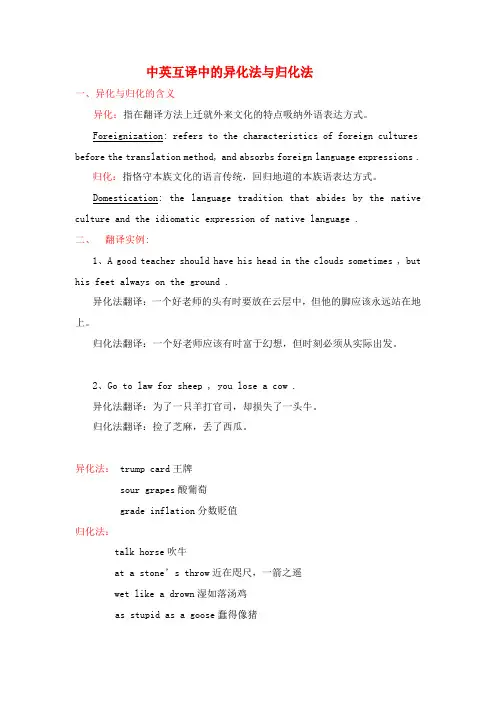
中英互译中的异化法与归化法一、异化与归化的含义异化:指在翻译方法上迁就外来文化的特点吸纳外语表达方式。
Foreignization: refers to the characteristics of foreign cultures before the translation method, and absorbs foreign language expressions .归化:指恪守本族文化的语言传统,回归地道的本族语表达方式。
Domestication: the language tradition that abides by the native culture and the idiomatic expression of native language .二、翻译实例:1、A good teacher should have his head in the clouds sometimes , but his feet always on the ground .异化法翻译:一个好老师的头有时要放在云层中,但他的脚应该永远站在地上。
归化法翻译:一个好老师应该有时富于幻想,但时刻必须从实际出发。
2、Go to law for sheep , you lose a cow .异化法翻译:为了一只羊打官司,却损失了一头牛。
归化法翻译:捡了芝麻,丢了西瓜。
异化法: trump card王牌sour grapes酸葡萄grade inflation分数贬值归化法:talk horse吹牛at a stone’s throw近在咫尺,一箭之遥wet like a drown湿如落汤鸡as stupid as a goose蠢得像猪A big reward will make the brave come forward. 重赏之下,必有勇夫。
Only a headhunter like Bo Le---an ancient Chinese good at headhunting fine steeds---can discover talented people. 有伯乐而后得千里马。
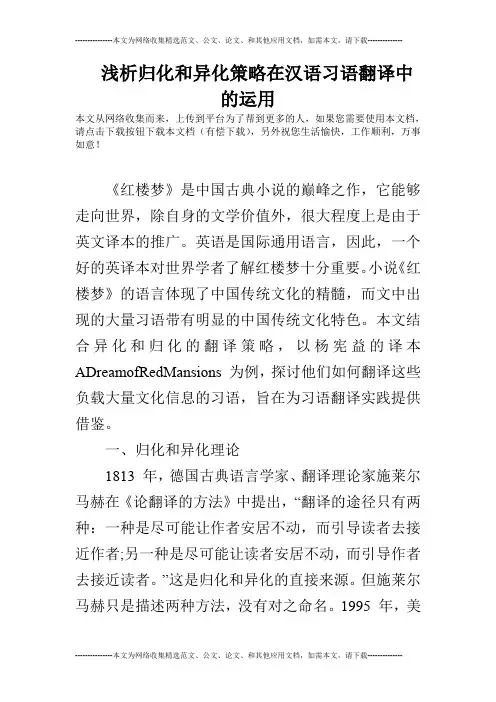
浅析归化和异化策略在汉语习语翻译中的运用本文从网络收集而来,上传到平台为了帮到更多的人,如果您需要使用本文档,请点击下载按钮下载本文档(有偿下载),另外祝您生活愉快,工作顺利,万事如意!《红楼梦》是中国古典小说的巅峰之作,它能够走向世界,除自身的文学价值外,很大程度上是由于英文译本的推广。
英语是国际通用语言,因此,一个好的英译本对世界学者了解红楼梦十分重要。
小说《红楼梦》的语言体现了中国传统文化的精髓,而文中出现的大量习语带有明显的中国传统文化特色。
本文结合异化和归化的翻译策略,以杨宪益的译本ADreamofRedMansions 为例,探讨他们如何翻译这些负载大量文化信息的习语,旨在为习语翻译实践提供借鉴。
一、归化和异化理论1813 年,德国古典语言学家、翻译理论家施莱尔马赫在《论翻译的方法》中提出,“翻译的途径只有两种:一种是尽可能让作者安居不动,而引导读者去接近作者;另一种是尽可能让读者安居不动,而引导作者去接近读者。
”这是归化和异化的直接来源。
但施莱尔马赫只是描述两种方法,没有对之命名。
1995 年,美国翻译理论家劳伦斯·韦努蒂将第一种方法称作“异化法”(Fore ignizing Method),将第二种方法称作“归化法”(Domesticating Method)。
所谓异化,就是在传递原文信息时,尽量保留原文的语言文化、文体等,要求读者向作者靠近,保持原文的异国情调;而归化则是改变原文的一些特征,用读者的语言习惯去表达原文内容,让作者向译文读者靠拢,去适应读者。
由于中外历史文化及地域方面的差异,在翻译过程中想要找出完全对等的译作,传达出原文包含的所有相关背景文化等内容,几乎是不可能的。
因此,在翻译过程中,要根据具体情况,辩证地使用归化和异化这两种翻译策略。
异化可以最大限度地再现原文的文化背景和民族特色,使目标语读者接触到更多异国风情,开阔目标语读者的视野,丰富目标语词汇。
归化则会使译文语言更符合目标语读者习惯,使读者阅读顺畅,易于理解。
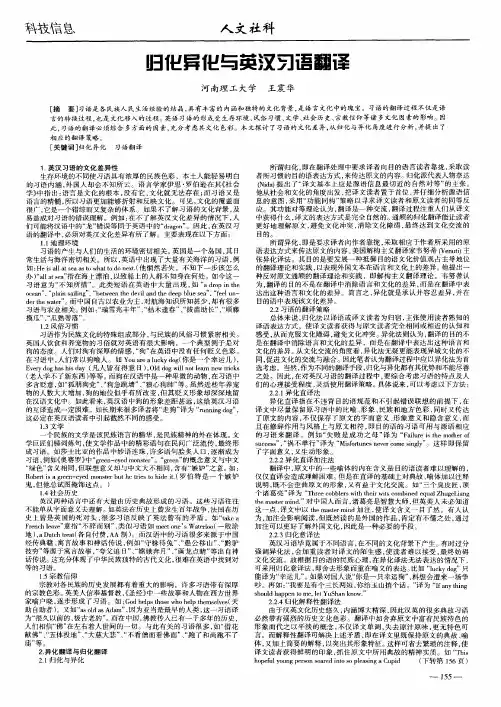
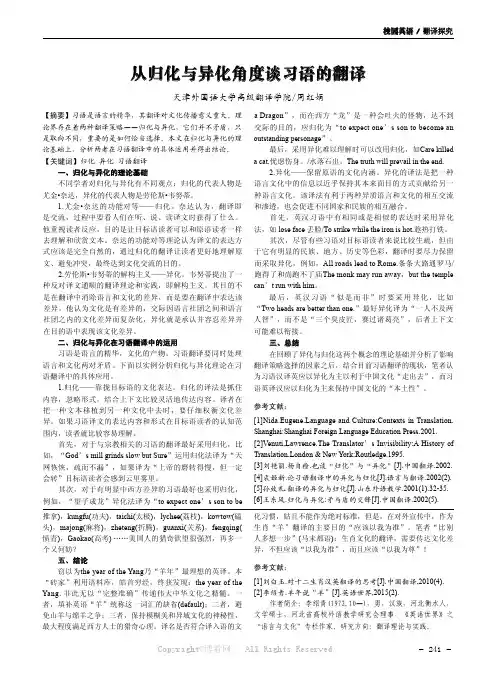
校园英语 / 翻译探究从归化与异化角度谈习语的翻译天津外国语大学高级翻译学院/周红娟【摘要】习语是语言的精华,其翻译对文化传播意义重大。
理论界存在着两种翻译策略——归化与异化,它们并不矛盾,只是取向不同,重要的是如何恰当选择。
本文在归化与异化的理论基础上,分析两者在习语翻译中的具体运用并得出结论。
【关键词】归化 异化 习语翻译一、归化与异化的理论基础不同学者对归化与异化有不同观点:归化的代表人物是尤金•奈达,异化的代表人物是劳伦斯•韦努蒂。
1.尤金•奈达的功能对等——归化。
奈达认为,翻译即是交流,过程中要看人们在听、说、读译文时获得了什么。
他重视读者反应,目的是让目标语读者可以和原语读者一样去理解和欣赏文本。
奈达的功能对等理论认为译文的表达方式应该是完全自然的,通过归化的翻译让读者更好地理解原文、避免冲突,最终达到文化交流的目的。
2.劳伦斯•韦努蒂的解构主义——异化。
韦努蒂提出了一种反对译文通顺的翻译理论和实践,即解构主义。
其目的不是在翻译中消除语言和文化的差异,而是要在翻译中表达该差异。
他认为文化是有差异的,交际因语言社团之间和语言社团之内的文化差异而复杂化,异化就是承认并容忍差异并在目的语中表现该文化差异。
二、归化与异化在习语翻译中的运用习语是语言的精华,文化的产物。
习语翻译要同时处理语言和文化两对矛盾。
下面以实例分析归化与异化理论在习语翻译中的具体应用。
1.归化——靠拢目标语的文化表达。
归化的译法是抓住内容,忽略形式,结合上下文比较灵活地传达内容。
译者在把一种文本移植到另一种文化中去时,要仔细权衡文化差异。
如果习语译文的表达内容和形式在目标语读者的认知范围内,读者就比较容易理解。
首先,对于与宗教相关的习语的翻译最好采用归化,比如,“God’s mill grinds slow but Sure”运用归化法译为“天网恢恢,疏而不漏”,如果译为“上帝的磨转得慢,但一定会转”目标语读者会感到云里雾里。
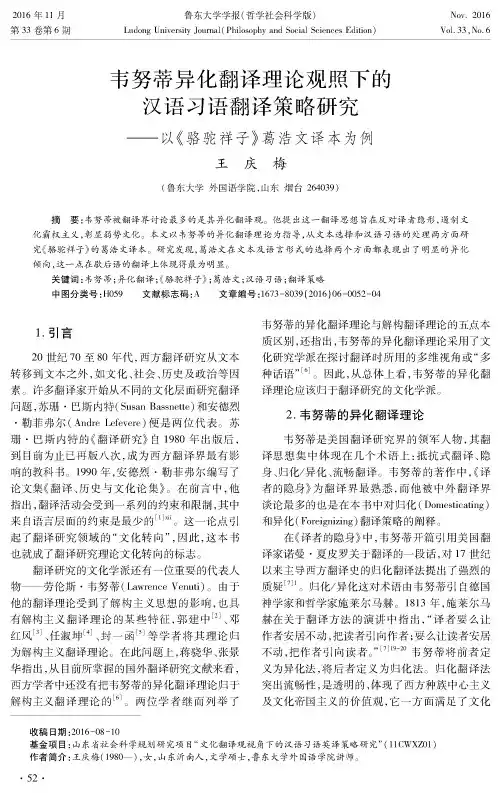
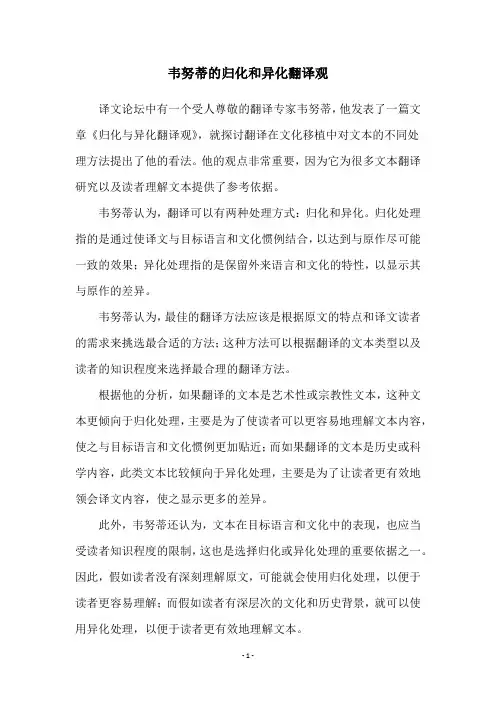
韦努蒂的归化和异化翻译观译文论坛中有一个受人尊敬的翻译专家韦努蒂,他发表了一篇文章《归化与异化翻译观》,就探讨翻译在文化移植中对文本的不同处理方法提出了他的看法。
他的观点非常重要,因为它为很多文本翻译研究以及读者理解文本提供了参考依据。
韦努蒂认为,翻译可以有两种处理方式:归化和异化。
归化处理指的是通过使译文与目标语言和文化惯例结合,以达到与原作尽可能一致的效果;异化处理指的是保留外来语言和文化的特性,以显示其与原作的差异。
韦努蒂认为,最佳的翻译方法应该是根据原文的特点和译文读者的需求来挑选最合适的方法;这种方法可以根据翻译的文本类型以及读者的知识程度来选择最合理的翻译方法。
根据他的分析,如果翻译的文本是艺术性或宗教性文本,这种文本更倾向于归化处理,主要是为了使读者可以更容易地理解文本内容,使之与目标语言和文化惯例更加贴近;而如果翻译的文本是历史或科学内容,此类文本比较倾向于异化处理,主要是为了让读者更有效地领会译文内容,使之显示更多的差异。
此外,韦努蒂还认为,文本在目标语言和文化中的表现,也应当受读者知识程度的限制,这也是选择归化或异化处理的重要依据之一。
因此,假如读者没有深刻理解原文,可能就会使用归化处理,以便于读者更容易理解;而假如读者有深层次的文化和历史背景,就可以使用异化处理,以便于读者更有效地理解文本。
总的来说,韦努蒂的“归化和异化翻译观”非常重要,他的观点指出了翻译文本在文化移植中的不同处理方式。
其实,无论是归化还是异化,翻译者都应当根据原文的特性和读者的需要,选择最适合的翻译方法,以保持原文内容不变,使得读者能够更好地理解。
同时,翻译者还要考虑到读者的知识程度,从而挑选最合理的归化或异化处理方式。
最后,翻译者有责任为读者提供一个更加贴近原文的文化移植结果。
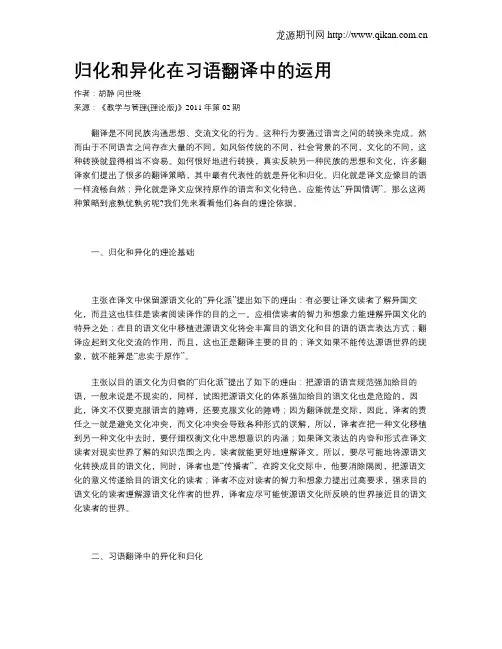
归化和异化在习语翻译中的运用作者:胡静闫世晓来源:《教学与管理(理论版)》2011年第02期翻译是不同民族沟通思想、交流文化的行为。
这种行为要通过语言之间的转换来完成。
然而由于不同语言之间存在大量的不同,如风俗传统的不同,社会背景的不同,文化的不同,这种转换就显得相当不容易。
如何很好地进行转换,真实反映另一种民族的思想和文化,许多翻译家们提出了很多的翻译策略,其中最有代表性的就是异化和归化。
归化就是译文应像目的语一样流畅自然;异化就是译文应保持原作的语言和文化特色,应能传达“异国情调”。
那么这两种策略到底孰优孰劣呢?我们先来看看他们各自的理论依据。
一、归化和异化的理论基础主张在译文中保留源语文化的“异化派”提出如下的理由:有必要让译文读者了解异国文化,而且这也往往是读者阅读译作的目的之一。
应相信读者的智力和想象力能理解异国文化的特异之处;在目的语文化中移植进源语文化将会丰富目的语文化和目的语的语言表达方式;翻译应起到文化交流的作用,而且,这也正是翻译主要的目的;译文如果不能传达源语世界的现象,就不能算是“忠实于原作”。
主张以目的语文化为归宿的“归化派”提出了如下的理由:把源语的语言规范强加给目的语,一般来说是不现实的,同样,试图把源语文化的体系强加给目的语文化也是危险的,因此,译文不仅要克服语言的障碍,还要克服文化的障碍;因为翻译就是交际,因此,译者的责任之一就是避免文化冲突,而文化冲突会导致各种形式的误解,所以,译者在把一种文化移植到另一种文化中去时,要仔细权衡文化中思想意识的内涵;如果译文表达的内容和形式在译文读者对现实世界了解的知识范围之内,读者就能更好地理解译文。
所以,要尽可能地将源语文化转换成目的语文化,同时,译者也是“传播者”,在跨文化交际中,他要消除隔阂,把源语文化的意义传递给目的语文化的读者;译者不应对读者的智力和想象力提出过高要求,强求目的语文化的读者理解源语文化作者的世界,译者应尽可能使源语文化所反映的世界接近目的语文化读者的世界。

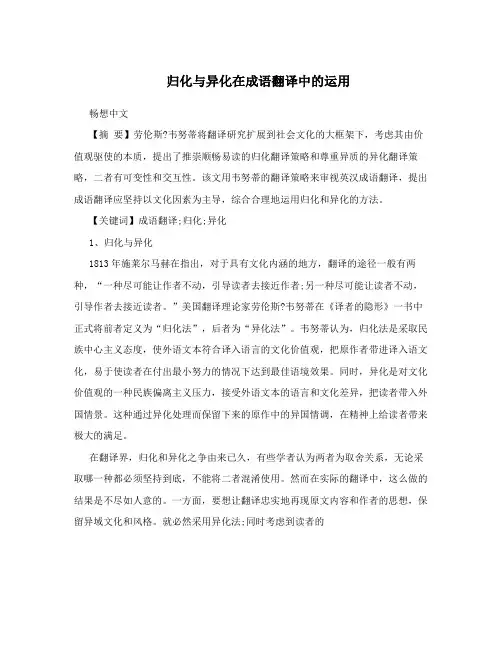
归化与异化在成语翻译中的运用畅想中文【摘要】劳伦斯?韦努蒂将翻译研究扩展到社会文化的大框架下,考虑其由价值观驱使的本质,提出了推崇顺畅易读的归化翻译策略和尊重异质的异化翻译策略,二者有可变性和交互性。
该文用韦努蒂的翻译策略来审视英汉成语翻译,提出成语翻译应坚持以文化因素为主导,综合合理地运用归化和异化的方法。
【关键词】成语翻译;归化;异化1、归化与异化1813年施莱尔马赫在指出,对于具有文化内涵的地方,翻译的途径一般有两种,“一种尽可能让作者不动,引导读者去接近作者;另一种尽可能让读者不动,引导作者去接近读者。
”美国翻译理论家劳伦斯?韦努蒂在《译者的隐形》一书中正式将前者定义为“归化法”,后者为“异化法”。
韦努蒂认为,归化法是采取民族中心主义态度,使外语文本符合译入语言的文化价值观,把原作者带进译入语文化,易于使读者在付出最小努力的情况下达到最佳语境效果。
同时,异化是对文化价值观的一种民族偏离主义压力,接受外语文本的语言和文化差异,把读者带入外国情景。
这种通过异化处理而保留下来的原作中的异国情调,在精神上给读者带来极大的满足。
在翻译界,归化和异化之争由来已久,有些学者认为两者为取舍关系,无论采取哪一种都必须坚持到底,不能将二者混淆使用。
然而在实际的翻译中,这么做的结果是不尽如人意的。
一方面,要想让翻译忠实地再现原文内容和作者的思想,保留异域文化和风格。
就必然采用异化法;同时考虑到读者的理解和接受以及合理恰当的表达原文的意思,因而采用归化法也是必然。
用“取一舍一”的态度对待归化和异化的翻译策略是不现实的。
只有兼顾两者,优势互补,才能达到理想的翻译效果。
2、成语的翻译2.1成语的归化翻译法将英语成语进行汉译时采用归化译法,是指用目的语中固有的成语(即汉语成语)来翻译英语成语。
因这些固有成语在意义、风格、色彩等方面与源语相当,且具有同等的习惯用法,这样的译法使目的语通俗流畅,消除了英语成语的一些异质性。
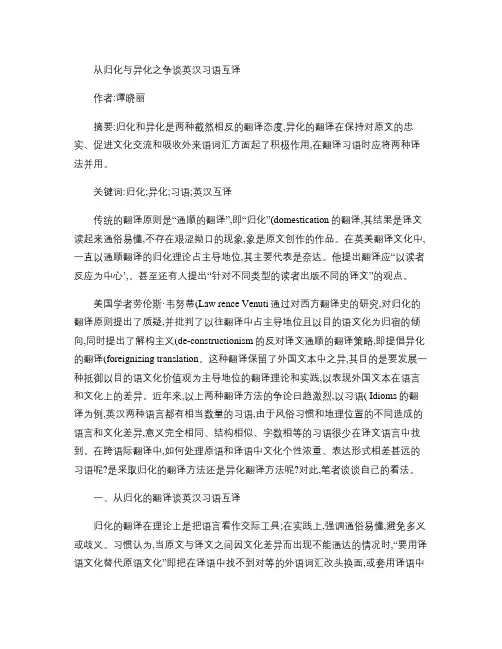
从归化与异化之争谈英汉习语互译作者:谭晓丽摘要:归化和异化是两种截然相反的翻译态度,异化的翻译在保持对原文的忠实、促进文化交流和吸收外来语词汇方面起了积极作用,在翻译习语时应将两种译法并用。
关键词:归化;异化;习语;英汉互译传统的翻译原则是“通顺的翻译”,即“归化”(domestication的翻译,其结果是译文读起来通俗易懂,不存在艰涩拗口的现象,象是原文创作的作品。
在英美翻译文化中,一直以通顺翻译的归化理论占主导地位,其主要代表是奈达。
他提出翻译应“以读者反应为中心’,。
甚至还有人提出“针对不同类型的读者出版不同的译文”的观点。
美国学者劳伦斯·韦努蒂(Law rence Venuti通过对西方翻译史的研究,对归化的翻译原则提出了质疑,并批判了以往翻译中占主导地位且以目的语文化为归宿的倾向,同时提出了解构主义(de-constructionism的反对译文通顺的翻译策略,即提倡异化的翻译(foreignizing translation。
这种翻译保留了外国文本中之异,其目的是要发展一种抵御以目的语文化价值观为主导地位的翻译理论和实践,以表现外国文本在语言和文化上的差异。
近年来,以上两种翻译方法的争论日趋激烈,以习语( Idioms的翻译为例,英汉两种语言都有相当数量的习语,由于风俗习惯和地理位置的不同造成的语言和文化差异,意义完全相同、结构相似、字数相等的习语很少在译文语言中找到。
在跨语际翻译中,如何处理原语和译语中文化个性浓重、表达形式相差甚远的习语呢?是采取归化的翻译方法还是异化翻译方法呢?对此,笔者谈谈自己的看法。
一、从归化的翻译谈英汉习语互译归化的翻译在理论上是把语言看作交际工具;在实践上,强调通俗易懂,避免多义或歧义。
习惯认为,当原文与译文之间因文化差异而出现不能通达的情况时,“要用译语文化替代原语文化”即把在译语中找不到对等的外语词汇改头换面,或套用译语中与之相似的现成的表达法,把它们变成读者熟悉的译语文化形象。
语言研究文化传播视角下英汉习语的异化翻译刘 冰 张珍煦【摘 要】本文依据劳伦斯 韦努蒂的异化理论,从英汉习语异化翻译的优势与不足、翻译方法说明英汉习语异化翻译有利于文化的交流与传播。
【关键词】异化 习语 文化传播一、前言异化与归化是1995年美国翻译理论家劳伦斯•韦努蒂(Laurence Venuti)在其著作《译者的隐形》中提出的概念。
这些概念源自德国哲学家斯莱马赫(Schleiermacher)1813年在他的论文《论翻译的方法》中阐述的翻译方法。
异化指译者让作者安居不动,引导读者靠近作者;归化指译者让读者安居不动,引导作者靠近读者。
习语,一般指语言中相沿习用的定型化的固定词组或句子,语义紧密、语音和谐,是语言中独立运用的词汇单位。
它们以现成的形式和固定的意义存在于语言当中,使用时一般不能任意改变其形式,其蕴含的意义往往难以从词组中单个词的意思推测而得。
习语有其独特的民俗文化、宗教、历史和文学渊源,对习语翻译的探讨有助于文化的交流与传播。
二、英汉习语异化翻译的优势与不足(一)英汉习语异化翻译优势英汉习语异化翻译能高度体现习语隐含的民俗文化。
众所周知,西方人对狗偏爱有加,视狗为伴侣和爱宠,习语中含有“狗”的褒义用法比比皆是,例如:“love me love my dog”。
在中国,与“狗”有关的习语大多含有贬义,诸如狗仗人势,狗眼看人低等。
在翻译此类习语时,采用异化的翻译策略有助于保留源语中暗含的价值观和生活方式。
所以笔者并不推崇将“love me love my dog”翻译为“爱屋及乌”,可直接异化翻译为“爱我与狗”。
英汉习语异化翻译能传达习语特有的历史文化。
文化传播目的是让本国的传统文化走出国门,同时学习其他国家的历史文化。
在翻译此类习语时,必须保留其文化内涵。
例如翻译习语“说曹操曹操到”,人们往往采用归化的翻译策略译成“speak of the devil and he is sure to appear”。
2019年20期总第460期ENGLISH ON CAMPUS归化与异化翻译策略指导下的英汉互译文/罗泽元一、引言随着中外人文与文化交流的不断加强,翻译在其中发挥的作用越来越突显,这也引起译者的高度重视。
而在英汉互译的实践中,源语中的一些表达方式和词句具有其特定的语言内涵和文化特色,而译者也许对此并不熟悉或了解,因此会给译者的翻译工作带来一定的阻碍和挑战。
同时,在一定程度上这也会影响着翻译质量的优劣。
在归化与异化翻译策略的指导下,本文旨在探讨英汉互译过程中主要体现的语言形式和文化特性等层面的差异,以更好地展示异国特色文化的风采,为解决今后同类型问题提供借鉴。
二、劳伦斯·韦努蒂的归化与异化翻译策略概述1995年,美国著名翻译理论学家劳伦斯﹒韦努蒂在《译者的隐身》中提出归化和异化翻译术语。
归化翻译是指译文应该更加倾向于以目的语文化为归宿,选择目的语读者所适应的表达习惯来对源文加以诠释,以消除源文所带来的文化差异,加强读者对源文和译文的理解;而异化翻译是指译文应该更加倾向于以源语文化为归宿,保留源语的文化特色,充分展现源语的语言特色和表达方式,以使读者充分感受源语的异域文化特色。
【摘要】劳伦斯·韦努蒂提出的归化与异化两种翻译策略为促进英汉互译翻译研究提供了新的理论视角。
本文尝试分析如何利用归化与异化翻译策略在英汉互译中的作用,尽可能地达到准确地传达作者的原意,便于读者理解,同时又充分体现源语和目的语两者之间不同的语言形式和文化特性的目的。
【关键词】归化;异化;翻译策略;英汉互译【作者简介】罗泽元(1993-),男,湖南衡阳人,湘潭大学外国语学院翻译硕士研究生,研究方向:英语笔译。
的原因。
下文就从接受美学角度,比较分析叶芝诗歌The Lake Isle of Innisfree的李正栓译本和艾梅译本。
1.李正栓译本赏析。
《茵尼斯弗利岛》李正栓译本:“/我要起身,现在就走,去茵尼斯弗利岛,/用泥土和枝条建造一个小屋,/种上九架芸豆,为蜜蜂建一蜂巢,/在蜜蜂高唱的林间幽居独处。
英汉翻译中异化法与归化法的正确认识前言一直以来,无论是在我国还是在西方,直译(literal translation)与意译(liberal translation)是两种在实践中运用最多,也是被讨论研究最多的方法。
1995年,美籍意大利学者劳伦斯-韦努蒂(Lawrence Venuti)提出了归化(domestication)与异化(foreignization)之说,将有关直译与意译的争辩转向了对于归化与异化的思考。
归化与异化之争是直译与意译之争的延伸,是两对不能等同的概念。
直译和意译主要集中于语言层面,而异化和归化则突破语言的范畴,将视野扩展到语言、文化、思维、美学等更多更广阔的领域。
异化和归化是在1995年由美国翻译理论家劳伦斯·韦努蒂在《译者的隐形》(The Translator‘s Invisibility)一书中提出来的。
从历史上看,异化和归化可以视为直译和意译的概念延伸,但又不完全等同于直译和意译。
直译和意译所关注的核心问题是如何在语言层面处理形式和意义,而异化和归化则突破了语言因素的局限,将视野扩展到语言、文化和美学等因素。
直译和意译主要是局限于语言层面的价值取向,异化和归化则是立足于文化大语境下的价值取向。
归化(domestication)是指在翻译中采用透明、流畅的风格,最大限度地淡化原文的陌生感的翻译策略。
它应尽可能的使源语文本所反映的世界接近目的语文化读者的世界,从而达到源语文化与目的语文化之间的“文化对等”。
异化(foreignization)是指偏离本土主流价值观,保留原文的语言和文化差异(Venuti,2001:240)[1];或指在一定程度上保留原文的异域性,故意打破目标语言常规的翻译。
它主张在译文中保留源语文化,丰富目的语文化和目的语的语言表达方式。
归化法要求译者向译语读者靠拢,采取译语读者习惯的译语表达方式,来传达原文的内容;异化法则要求译者向作者靠拢,采取相应于作者使用的原语表达方式,来传达原文的内容。
从译文实例看韦努蒂归化异化策略[Abstract]Domestication and foreignisation are two translation strategies suggested by Venuti. This paper explains their connotations and methods which have something in common with traditional linguistic approaches. The concept of the two strategies is helpful in evaluating the translation activity and the position of the translator from the point of translation history. However, their shortcomings are obvious. By analysing three famous translations between English and Chinese, the author points out the limitation in guidance of both strategies. The conclusion is Venuti’s strategies are rooted only in a specific background of history, culture and politics. When translating from Western languages into the Third World’s languages, the translator should do much research into specific national conditions; essentially, he/she should abide by the democratic thought which is the basis of Venuti’s strategies. Only in this way can the translation maintain the innate cultural elements so as to safeguard the target language and the target culture.[Key words]domestication,foreignisation,translation strategies,Anglo-American cultureDomestication and foreignisation are two translation strategies suggested by Lawrence Venuti. Domestication “entails transla ting in a transparent, fluent, ‘invisible’style in order to minimize the foreignnessof the TT [target text].”\[1\]144 Foreignisation, also called resistancy or minoritizing translation, is “a non-fluent or estranging translation style designed to make visible the presence of the translator by highlighting the foreign identity of the ST [source text]and protecting it from the ideological dominance of the target culture”.\[1\]145There are two issues to consider when applying the strategies. The first is the choice of the foreign texts. Domestication favours the ST which conforms to the domestic cultural values whilst foreignisation prefers those standing in a peripheral position within the source culture; that is those kinds of texts may be neglected by either the source or target readership. The other issue is the selection of the translation methods. Domestication is a target-oriented approach, through which the message is conveyed in the mode of the target culture, even at the cost of adopting as Berman lists “hypertextual translation” including pastiche, imitation, adaptation, free writing.\[2\]278 On the other hand, in order to retain the strangeness of the ST, foreignisation tries to keep a distance from its target readers.In the selection of methodology, these two strategies have something in common with traditional linguistic approaches. Direct translation and oblique translation proposed by Vinay and Darbelnet can be seen as the operating methods of foreignisation and domestication respectively.Ho wever, they are different from “the linguistics-oriented approaches based on pragmatics and text linguistics”.\[3\]103 Venuti’s strategies are dynamic, involving more elements including not only linguistics, but also aesthetics, culture and politics.\[4\]194 These elements enlarge the range of translation studies. When discussing translation, we move beyond the domain of language, investigating translation activity with influences from social ideology, politics and other factors. The two strategies are not limited to the superficial pursuit of literary equivalence, but, rather, focus also on national spirit and political issues.The concept of the two strategies is helpful in evaluating the translation activity and the position of the translator from the point of translation history. Fawcett describes the network of the publishing industry as a “power play” in which editors and copy-editors are players.\[1\]151 In the network, the translator has no position of power. Nevertheless, on the basis of discursive heterogeneity, foreignizing translation gives the translator more responsibilities and obligations. He has to not only demonstrate the heterogeneity of the ST in linguistic and cultural aspects, but also initiate the reformulation of the target culture and cut across the literary hierarchies by releasing the minor variants or, in Lecercle’s terminology, “remainders”\[5\]484, which vary from the standard dialect but are often ignored by the popular masses.However, as a guide to translation practice, the two strategies can be only used in a limited way. First, the effect of the strategies is complex. The distinction between domestication and foreignisation is sometimes unclear. They are not simple binary opposites, but in Venuti’s words: “They possess a contingent variability.”\[6\]146 What they can provide is simply a way of thinking, aiming to attract more attention to the autonomous existence of texts. According to Munday’s understanding, the terms of domestication and foreignisation are not clearly defined. As Venuti further explains: “They can only be defined in the specific cultural situation in which a translation is made and works its effects”.(ibid) From this point of view, the unclear boundary of the two strategies becomes less controllable. The translating process starts with the receiving of the foreign text and ends when the TT is submitted. As for the social effects of a TT, it has nothing to do with the quality of the product itself. With regard to the far-reaching consequences, any previous TT and later TTs share no common cultural situation. So the effect of the previous strategy cannot give any clue for later translators.Secondly, it seems that foreignisation can only be adopted in Anglo-American culture. Resistant translation is rooted in the fight against Anglo-American cultural imperialism. It is said in domestication translation that the medium of the powerful culture integrates, colonizes and marginalizes the minor native culture. Perhaps Toury’s law ofinterference can properly explain why domestication translation is usual in the language of Anglo-American culture: “Tolerance of interference—and hence the endurance of its manifestations—tend to increase when translation is carried out from a ‘major’or highly prestigious language/culture, especially if the target language/ culture is ‘minor’, or ‘weak’.”\[7\]278 For example, Shakespear’s plays boast unmatched reputation in the world plays. The translator tends to follow his canonized model. Here are four lines of the play Merchant of Venice: It is enthroned in the hearts of kings,It is an attribute to God himself;And earthly power doth then show likest God’sWhen mercy seasons justice.\[8\]825Chinese version by Zhu Shenghao: “慈悲的力量却高于权力之上,它深藏在帝王的内心,是一种属于上帝的德性,执法的人倘能把慈悲调剂着公道,人间的权力就和上帝的神力没有差别”。
舌尖上的中国英译中归化和异化翻译策略运用范文2018-10-24归化与异化是翻译时普遍使用的两种翻译策略,由美国著名翻译理论学家劳伦斯・韦努蒂提出。
详细内容请看下文舌尖上的中国英译中归化和异化翻译策略运用。
归化指在翻译时尽量向目的语的读者靠拢,采取目的语习惯的表达方式翻译原文;而异化则是翻译时向源语作者靠拢,尽量在保留源语的表达方式后进行翻译。
归化与异化是对立统一的,译者在翻译时通常会综合运用归化法与异化法。
随着中国的发展壮大与全球化趋势的进一步增强,世界对中国的关注与日俱增。
以中华饮食为代表的中国文化成了外国人了解中国的一个重要窗口。
在此背景下,纪录片《舌尖上的中国》(以下简称《舌尖》)自2017年5月首播以来,引起了国内外人士的广泛关注与热烈讨论。
《舌尖》主要介绍了中国各地的美食生态,从多个侧面展示了中华民族博大精深的饮食文化。
《舌尖》的字幕翻译作为中国纪录片外宣的典范,受到了海外观众较好的评价。
本文以《舌尖》中英文脚本为语料,对《舌尖》脚本中译英过程中归化和异化翻译策略的运用情况进行统计和分析,并归纳总结在翻译具有鲜明中国文化色彩的中文纪录片时,如何在归化和异化这两种翻译策略中间取得最佳平衡,以实现译文的忠实、通顺,并通过影视这一特殊载体,实现翻译目的,为类似纪录片的英译提供指导和参考,服务国家的文化走出去战略。
影视翻译的瞬间性、通俗性以及观众多层次等诸多特点决定了影视翻译必须以译语观众为中心(李颜,2017:82),即中文纪录片翻译工作者在翻译时应充分考虑译语观众的欣赏角度与接受程度,向目的语靠拢。
此时,译者需要熟练应用归化法,以《舌尖》中菜名的翻译为例:腌笃鲜:bambooshootsoupwithfreshandpickledstreakypork。
蜜汁火方:braisedhaminhoneysauce。
炸藕夹:deep-friedlotusrootsandwich。
腊汁肉夹馍:chinesehamburger。
从韦努蒂归化与异化法看中英文习语翻译【摘要】长期以来,中英文习语就被学者以及其他对其感兴趣或经常运用它们的人广泛研究。
而另一方面,在过去的几十年中,随着翻译事业的飞速发展,有诸多耳熟能详的翻译理论和方法建立起来并被投入使用。
现在越来越多的人已意识到,习语往往出自日常生活及经历,它们形式灵活、通俗易懂。
可是也有很大一部分人认为,翻译理论在某种程度上可以说是固定而老套的,因此它们很难同实际翻译操作,尤其是同中外习语翻译结合起来。
基于此,本文以韦努蒂的归化及异化理论为中心,力图针对该理论展开对各类习语以及它们实际运用的分析和分类,继而归总了归化及异化理论何时、如何被应用于习语翻译,而这一部分也构成了本文的主旨所在。
总言之,该论文目的在于运用结合实例和理论指导的观点看习语翻译,以表明两者间和谐一致之关系。
【关键词】习语翻译;韦努蒂;归化;异化an analysis of idiom translation based on venuti’s domestication and foreignization strategy【abstract】english and chinese idioms have long been extensively studied by scholars as well as other people who are interested in or actively make use of them. on the other hand, during the past decades, along with the prosperous development of translation, various translation theories and methods have been formed and put into use. more and more peopleare now keenly aware that idioms, most of which are derived from our daily lives and actual experiences, are quite flexible and demotic, at the same time carrying abundant cultural specifics. but a large number of people hold such a point of view that formed theories are to some extent so theoretic and stereotyped that they cannot be connected to practical translations, especially that of english and chinese idioms. with this understanding, the paper centers upon lawrence venuti’s domestication and foreignization theories and attempts to provide an analysis and classifications of different idioms and their concrete applications according to the theories. furthermore, a sum-up of the actual cases when and how domestication and foreignization are preferred in idiom translation is carried out and constitute the pivot of the whole theme. in all, the paper aims to study and analyze idioms from a relatively combinative perspective, joint together their actual usages and theory guidance, in order to indicate the compatible role they play to each other.【key words】 idiom translation; venuti; domestication; foreignization【中图分类号】g623.31【文献标识码】b【文章编号】1001-4128(2011)07-0175-06contentsabstract in chineseabstract in englishintroduction1. background1.1 definition of idioms1.2 idiom translation and cultural specifics2. related strategies in idiom translation2.1 a brief review of some translation strategies2.2 venuti’s domestication and foreignization strategy 2.2.1 reason why venuti’s strategy is of special significance2.2.2 introduction to domestication and examples2.2.3 introduction to foreignization and examples2.2.4 summary of venuti’s translation strategy3. further study of venuti’s strategies in idiom translation3.1 classifications of methods used in idiom translation 3.1.1 foreignization and its concrete applications3.1.2 domestication and its concrete applications3.1.3 combination of the two and its concrete applications3.2 summary of the applications3.2.1 cases when domestication is preferred3.2.2 cases when foreignization is preferred3.2.3 cases when the combination of the two is preferred conclusionreferencesintroductionin recent years, the words “culture” and “translation”have been increasingly connected to each other. no great translation work can be done if the cultural background has not been taken into consideration or even if there remains a slight degree of misunderstanding in the cultural contexts. idiom, a special linguistic phenomenon and a succession of words, whose meaning is not obvious through knowledge of the individual meanings of the constituent words but must be learnt as a whole, conveys plenteous cultural messages. a failure to translate the cultural information shall no doubt result in the formation of non-idiomatic expressions. in short, idiomatization is a process, during which many factors interact. a good translation work will fully bring thesefactors into play and to a large extent, retain their cultural values.this paper intends to explore ways of treating cultural specifics in idiom translation by means of studying the practical translation methods according to different situations, since there is no “one-size-fits-all”translation methods used in idiom translation. therefore, here the arguments shall be based on the previously-raised strategies with its focus on venuti’s strategies and then go deeper to apply them to the actual usages of idiom translation, with the hope to avoid the non-idiomatic expressions in english and chinese.1. background1.1 definition of idioms。
although idioms constitute a fairly great part of our linguistic repertoire, actually the task of defining what an idiom is still remains a rather difficult and controversial one. a given structure is not idiomatic once and for all, but gradually acquires its idiomaticity. this helps to make idioms at the same time holistic and analyzable, although various scholars have raised different definitions on idioms.the oxford dictionary of current idiomatic english (cowie,2004: 158) defines idiom as “a language of a certain people or country, specific character of this.” while to take it more specifically, idioms are concluded words, phrases and short sentences through long time practice in history and daily living. moreover, according to the australian linguist chitra fernando (2001:1), idioms are “conventionalized multiword expressions, often but not always, non-literal”. apart from the definitions above, seen from appearances and forms, idioms are composed of freely occurring units whose global meaning cannot be reduced simply from the meanings of these units. at the same time, idioms in a broad sense may include: 1) set phrases, 2)proverbs, 3)sayings, 4)epigrams, 5)slang expressions, 6) colloquialisms, 7)quotations, 8) two-part allegorical sayings, etc.. in the examples in the following part of this paper, various types of idioms will be cited, with much attention paid to the commonly used set phrases and sayings.the above definition of idioms serves as a precondition for further study of idiom translations. there are two basic criteria to decide whether an expression is an idiom or not, so as to arouse the translators’ attention:first of all, each idiom is well-established and accepted through common practice. normally one cannot change the word order, or delete or add words to an idiom at random. for example, we can only say “the long and the short of it”instead of “the short and the long of it”. usually, an idiom allows no variation in form unless the writer is consciously making a joke or is attempting a play on words. secondly, an idiom often conveys an implied meaning. an idiom cannot always be interpreted only according to its literal meaning. for example, when taken literally, the phrased “at the eleventh hour” and “the man in the street”seem to be nonsense. but in their figurative sense, the former implies “the last moment”, whereas the latter refers to “an average person”, who represents general opinion.1.2 idiom translation and cultural specifics。